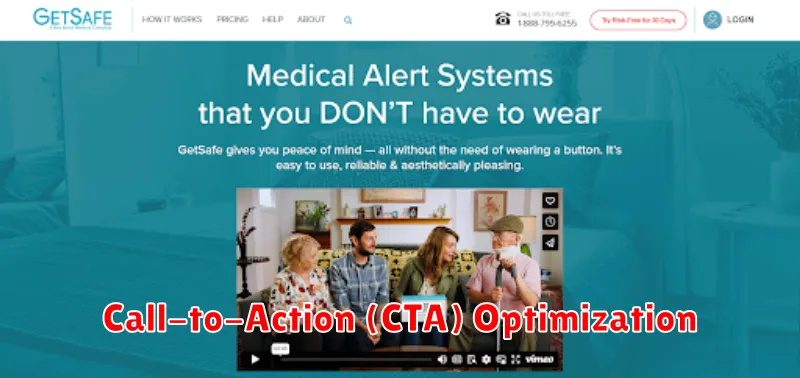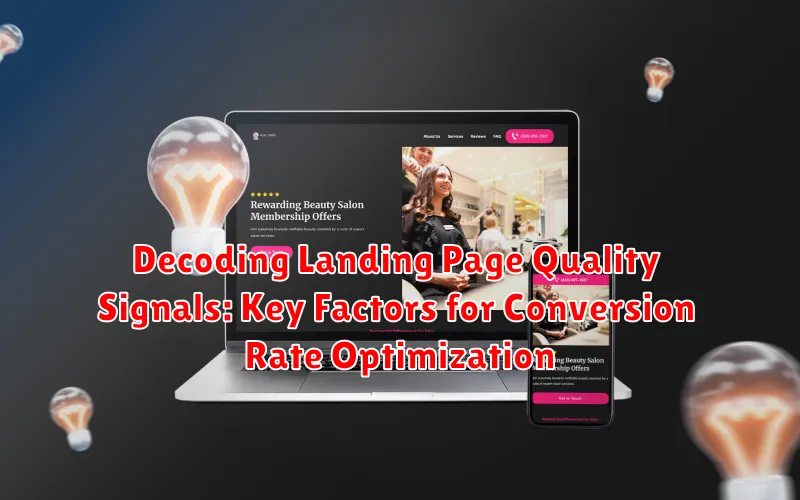In the realm of digital marketing, the landing page stands as a pivotal touchpoint, often the deciding factor in whether a visitor becomes a customer. Understanding and effectively leveraging landing page optimization techniques is paramount for businesses aiming to maximize their conversion rates and achieve a higher return on investment. This article delves into the critical quality signals that contribute to a high-performing landing page, offering actionable insights into how these factors can be strategically implemented to enhance user experience and drive conversions. We will explore universally applicable principles, ensuring that regardless of geographic location or industry, your landing pages resonate with your target audience and compel them to take the desired action.
Effective conversion rate optimization (CRO) necessitates a deep understanding of user behavior and the ability to translate those insights into actionable improvements on your landing pages. This comprehensive guide will decode the essential elements that contribute to a successful landing page, examining aspects such as page speed, mobile responsiveness, clear call-to-actions, compelling value propositions, and trustworthy design. By meticulously analyzing these quality signals, marketers and web developers alike can create landing pages that not only attract visitors but also effectively guide them through the conversion funnel, ultimately boosting leads and sales.
What are Landing Page Quality Signals?
Landing page quality signals are indicators that reflect the overall effectiveness and trustworthiness of a landing page in the eyes of users and search engines. These signals influence user behavior and conversion rates by impacting perceptions of relevance, credibility, and value.
Essentially, they are the subtle cues that tell a visitor whether the page is worth their time and whether they can trust the information and the offer presented. A strong collection of positive quality signals can significantly boost the likelihood of a visitor completing the desired action, such as making a purchase, filling out a form, or subscribing to a service.
Conversely, weak or negative signals can lead to high bounce rates and low conversion rates. Identifying and optimizing these signals is crucial for maximizing the performance of any online marketing campaign.
The Importance of Quality Signals for Conversions
Quality signals on a landing page directly impact conversion rates. A landing page that exhibits strong quality signals builds user trust and encourages them to take the desired action, whether it’s filling out a form, making a purchase, or subscribing to a newsletter. Conversely, a landing page lacking these signals can deter visitors, leading to high bounce rates and lost opportunities.
Prioritizing high-quality content, a seamless user experience, and clear calls to action are crucial for maximizing conversions. Ignoring these elements can result in wasted marketing efforts and a lower return on investment. By focusing on building and optimizing quality signals, businesses can create landing pages that effectively capture leads and drive sales.
Key Elements of a High-Quality Landing Page

A high-quality landing page is characterized by several key elements that contribute to its overall effectiveness. These elements work in harmony to provide a seamless and persuasive experience for the visitor, ultimately driving conversions.
Clear Value Proposition
A compelling value proposition clearly communicates the benefits of your offer and why visitors should choose you over the competition. It should be prominently displayed and easily understood within seconds.
Engaging Headline and Subheadline
The headline is the first thing visitors see, so it needs to grab their attention and clearly state the page’s purpose. The subheadline should expand on the headline, providing more context and reinforcing the value proposition.
Visually Appealing Design
The design should be clean, uncluttered, and visually appealing. Use high-quality images and videos to showcase your product or service and break up text.
Content Relevance and Clarity
Content relevance and clarity are paramount for a high-converting landing page. Visitors should immediately understand what you offer and how it addresses their needs.
Ensure the headline and body copy directly reflect the promise made in the ad or search result that brought them to the page. Inconsistencies erode trust and increase bounce rates.
Use clear, concise language, avoiding jargon or technical terms that your target audience may not understand. Simplicity is key to quickly conveying your message.
Visual cues, such as images and videos, should complement the text and reinforce the value proposition. They should be directly relevant to the product or service being offered.
Structure your content logically, using headings and subheadings to guide visitors through the information. Make it easy for them to scan the page and find the information they need.
Page Speed and Mobile Friendliness
Page speed and mobile friendliness are crucial quality signals that significantly impact conversion rates. Users expect websites to load quickly and function seamlessly across all devices. Slow loading times or a non-responsive design can lead to high bounce rates and lost opportunities.
Page Speed: Ideally, aim for a page load time of under three seconds. Utilize tools like Google PageSpeed Insights to identify areas for improvement, such as optimizing images, leveraging browser caching, and minifying CSS and JavaScript.
Mobile Friendliness: Ensure your landing page is fully responsive, adapting to different screen sizes and resolutions. A mobile-friendly design prioritizes touch-friendly navigation, legible text, and appropriately sized images for smaller screens.
Prioritizing these elements will not only improve user experience but also positively influence search engine rankings, further driving qualified traffic to your landing page.
User Experience (UX) and Design
User Experience (UX) and design are pivotal in shaping user perception and driving conversions on a landing page. A well-designed page ensures visitors can effortlessly navigate and find the information they seek.
Key considerations include:
- Intuitive Navigation: Clear pathways for users to explore the page.
- Visual Hierarchy: Employing size, color, and spacing to guide the eye to important elements.
- Mobile Responsiveness: Ensuring the page renders seamlessly across various devices.
- Accessibility: Designing for users with disabilities, adhering to WCAG guidelines.
Aesthetics also play a significant role. A clean, modern design instills confidence and professionalism. Using high-quality images and videos, consistent branding, and a well-chosen color palette enhances the overall user experience and reinforces the credibility of the offer.
Trust Signals and Credibility
Establishing trust and credibility is paramount for converting visitors into customers. Potential customers need assurance that your business is legitimate and reliable.
Key Trust Signals to Implement:
- Security Badges: Display recognized security badges (e.g., Norton Secured, McAfee Secure) to assure visitors their information is protected.
- SSL Certificate: Ensure your website uses HTTPS, indicated by a padlock icon in the browser’s address bar, signifying a secure connection.
- Testimonials and Reviews: Feature genuine customer testimonials and positive reviews prominently on your landing page.
- Guarantees and Warranties: Clearly state any guarantees, warranties, or refund policies offered.
- Contact Information: Provide accurate and easily accessible contact information, including phone number, email address, and physical address (if applicable).
- Privacy Policy: Link to a comprehensive privacy policy outlining how you handle user data.
By incorporating these trust signals, you can alleviate visitor concerns and increase their confidence in your offering, ultimately boosting conversion rates.
Call-to-Action (CTA) Optimization

Call-to-Action (CTA) optimization is a crucial aspect of landing page design, directly influencing conversion rates. A well-optimized CTA encourages users to take the desired action, whether it’s making a purchase, signing up for a newsletter, or requesting a demo.
Several factors contribute to effective CTA optimization:
- Compelling Copy: Use action-oriented language that clearly communicates the benefit to the user. Examples include “Get Started Today,” “Download Now,” or “Request a Free Quote.”
- Strategic Placement: Position CTAs prominently on the page, above the fold and within the natural flow of the content. Consider multiple CTAs for longer pages.
- Visual Design: Make CTAs visually appealing and easy to identify. Use contrasting colors, whitespace, and clear button styling to draw attention.
- A/B Testing: Experiment with different CTA variations (copy, color, size, placement) to determine what resonates best with your audience.
By carefully considering these elements, you can significantly improve the effectiveness of your CTAs and drive higher conversion rates on your landing pages.
Testing and Iteration for Continuous Improvement
Testing and iteration are paramount for the sustained optimization of landing page quality and, consequently, conversion rates. A/B testing, also known as split testing, provides a methodology for directly comparing two versions of a landing page element to determine which performs more effectively.
Key aspects of testing and iteration include:
- A/B Testing: Compare different versions of elements (e.g., headlines, CTAs, images) to identify improvements.
- Multivariate Testing: Test multiple elements simultaneously to understand their combined impact.
- Data Analysis: Rigorously analyze test results to understand user behavior and inform future changes.
- Iterative Refinement: Implement changes based on data-driven insights and continuously refine the landing page.
By embracing a culture of continuous testing and iterative improvement, marketers can systematically enhance the quality of their landing pages, resulting in significant increases in conversion rates and overall campaign effectiveness.
Analyzing Data to Identify and Improve Quality Signals
Data analysis is crucial for identifying areas where your landing page can be improved to boost conversion rates. By carefully examining user behavior and performance metrics, you can gain valuable insights into the effectiveness of your quality signals.
Key metrics to monitor include:
- Bounce Rate: Indicates the percentage of visitors who leave your page without interacting.
- Time on Page: Measures how long users spend on your landing page.
- Conversion Rate: Tracks the percentage of visitors who complete the desired action (e.g., sign-up, purchase).
- Click-Through Rate (CTR): Shows the percentage of users who click on your call-to-action.
- Exit Pages: Identifies the pages where users are leaving your site.
Tools like Google Analytics can provide comprehensive data on these metrics. Use A/B testing to experiment with different variations of your landing page, such as headlines, images, and CTAs. By analyzing the results, you can determine which changes have the most positive impact on your conversion rate and continuously refine your landing page for optimal performance.

